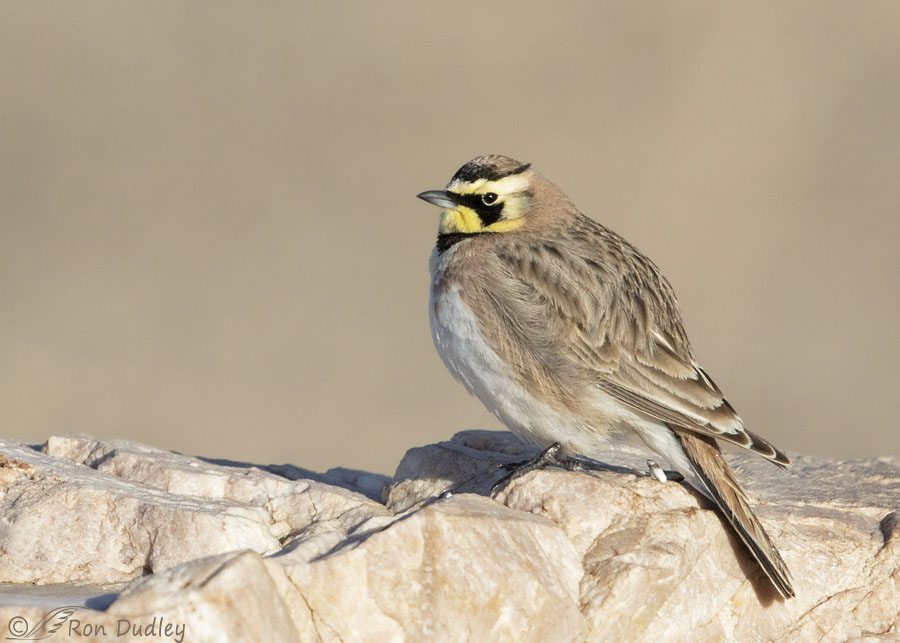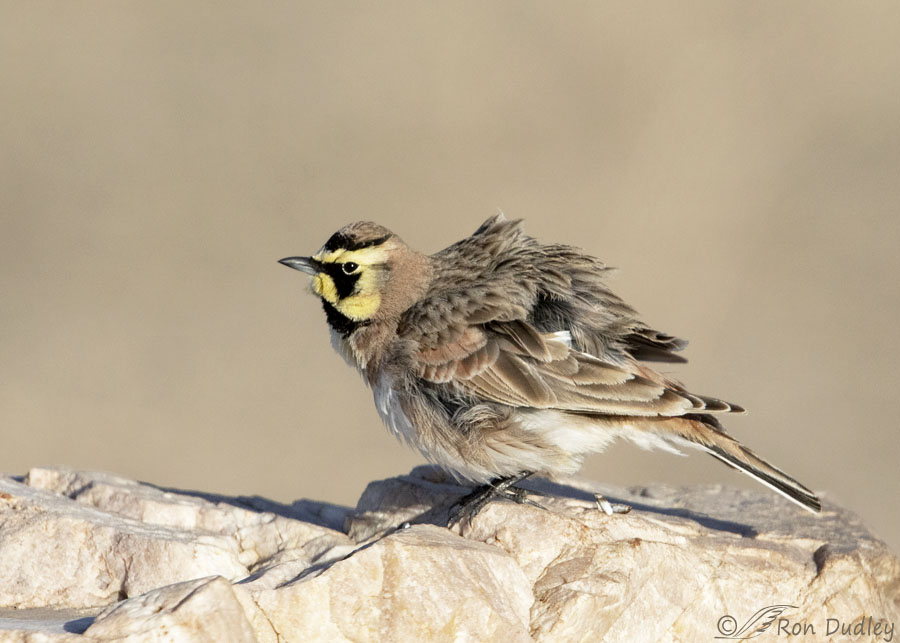The only member of the lark family that is native to the Americas.

1/4000, f/7.1, ISO 800, Canon 7D Mark II, Canon EF 500mm f/4L IS II USM + EF 1.4 III Extender, not baited, set up or called in
It had been a while since I’d photographed a Horned Lark but I couldn’t resist this one on Antelope Island three days ago. Typically on the island they perch on bright white rocks which aren’t particularly attractive in photos but this rock had some nice color to it so I fired away.
Yes, there’s a turd in the photo but with birds… poop happens.
This time of year the males are almost constantly singing their lovely soft song but I heard not a peep out of this one.

1/4000, f/7.1, ISO 800, Canon 7D Mark II, Canon EF 500mm f/4L IS II USM + EF 1.4 III Extender, not baited, set up or called in
He didn’t cooperate much in the posing department either. This rouse was the only other interesting pose I managed to get.
Within their range and typical habitat Horned Larks are common and somewhat nondescript so they don’t get a lot of attention. But I’ve always had a soft spot for them in part because they’re easily the most common bird on our northwest Montana family farm so seeing them and hearing their soft calls brings back fond memories.
Horned Larks are among the earliest of songbird nesters, nesting in early February even in the northern states. And they’re “philopatric,” meaning they return to their birthplace after each migration cycle.
I take issue with saying birds are “born” so I prefer to say they return to their “hatching place.”
Ron


I’m intrigued, whenever you “go into it.”
A rather rare bird here that I have not seen, although I have seen the Western Meadowlark, which, because you noted the Horned Lark is the only native one, I now know is not in the lark family at all. Another puzzling name that never ceases to irritate….
Agree about the name confusion, Lyle. If all goes according to plan (a big “if”) I may go into the reason for that confusion on tomorrow’s post.
Lovely little birds. They remind me of pronghorns in coloration patterns and those feathered horns. The similar colorations must help both bird and pronghorn since they frequently live in the same habitat.
Excellent observation about the similarities between them and pronghorns, April.
So *not* nondescript! Those horns! That yellow & black face! What I’d give to see one in my backyard fountain, which is often overflowing with LBJs (speaking of nondescript). Had to go to my iBird app to listen to its song—lovely! So I’m glad this little guy was cooperative enough that you could get at least a couple of nice shots — another one for me to be watching/listening for on bird hikes. 🙂
Chris, unless you get very close to the males the features you mention are very difficult to see and the females are less vivid than the males. Typically the casual observer pays very little attention to them.
But if you’re close, either physically or optically, they’re far from nondescript.
Pretty bird❗️Right now I have a mockingbird that is out singing every other bird in my yard right now😁
You’re lucky, Diana. About the only birds I’ve been hearing in my yard lately are starlings.
Yet another ‘common’ bird which isn’t in the slightest bit common to me. I do love those soft colours too.
Bird turds on the other hand ARE common. And judging by the difficulty I have in removing some laid under the bird feeders the rotten beasts have found a source of super glue to add to their diet.
That uric acid in their droppings is almost impossible to remove, EC. Uric acid isn’t water soluble so “super glue” is an apt analogy. Water is falsely advertised as a “universal solvent.”
When I used to spend hours power washing and scraping raptor poo off kennels and carpets I would wonder why scientists haven’t duplicate the formula of the raptor urates to use as outdoor house paint.
🙂
Such a charming little bird (turdlet notwithstanding)! I really like the weathering patterns in the rock; it makes a very attractive perch.
Thank you, Marty. “Turdlet”, I should have used that.
“He” looks sleepy or cold – lovely little lark….. 🙂 They tend to “get lost” with the noisier birds “talking” in the yard so see them more than hear them and that’s not often tho probably more like I’m not paying attention! 😉 Glad you’re about to “get out there” even if it’s not as productive as you’d like at the moment……
Judy, on the farm I rarely saw or heard them near the house but when I was working in the fields (which was often) they were omnipresent. Maybe it’s the same with them in your area…
Joe doesn’t recall seeing them in the field……. Of course, a couple hundred miles does make a difference……… 🙂
Beautiful photos Ron of a very attractive bird. We have them here not in any great numbers, but always nice to see. None of my photos of them come close to these two. Like that look in his eye in the second one. And you are right about the rocks. That particular formation goes very well with his colors. I am not familiar with the word philopatric so thank you for the education. Glad to see you are out there soon after your surgical procedure.
Thanks, Everett. Yes, I was “out there” but I didn’t have much feathered company. Hopefully birds will continue to pick up as we get into the nesting season.
Checkout the range map for this bird. It is practically everywhere in North America.
Yup.
Very nice…such cute ‘little devil’ birds with those little horns. Really like their colors. I do agree they do not pose very much…they are either running from you or sitting waiting for you to catch up to them so they can run again! Just love their song! If you can put a name to it I think of ‘tinkling bells’ for some reason…it is so melodic, soothing to me. When out driving, I keep my window open and typically hear them before I see them.
“Tinkling bells” is perfect, Kathy. It’s such a nice little song but you often have to listen carefully to hear it.